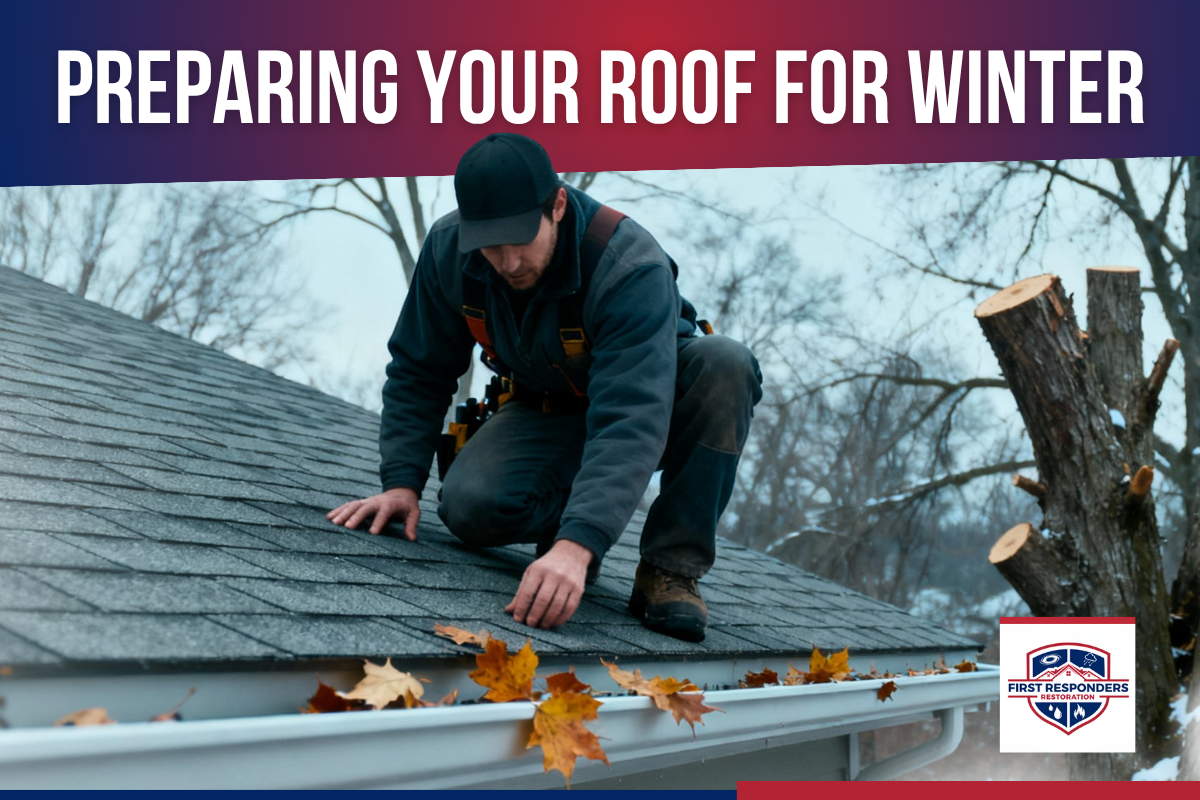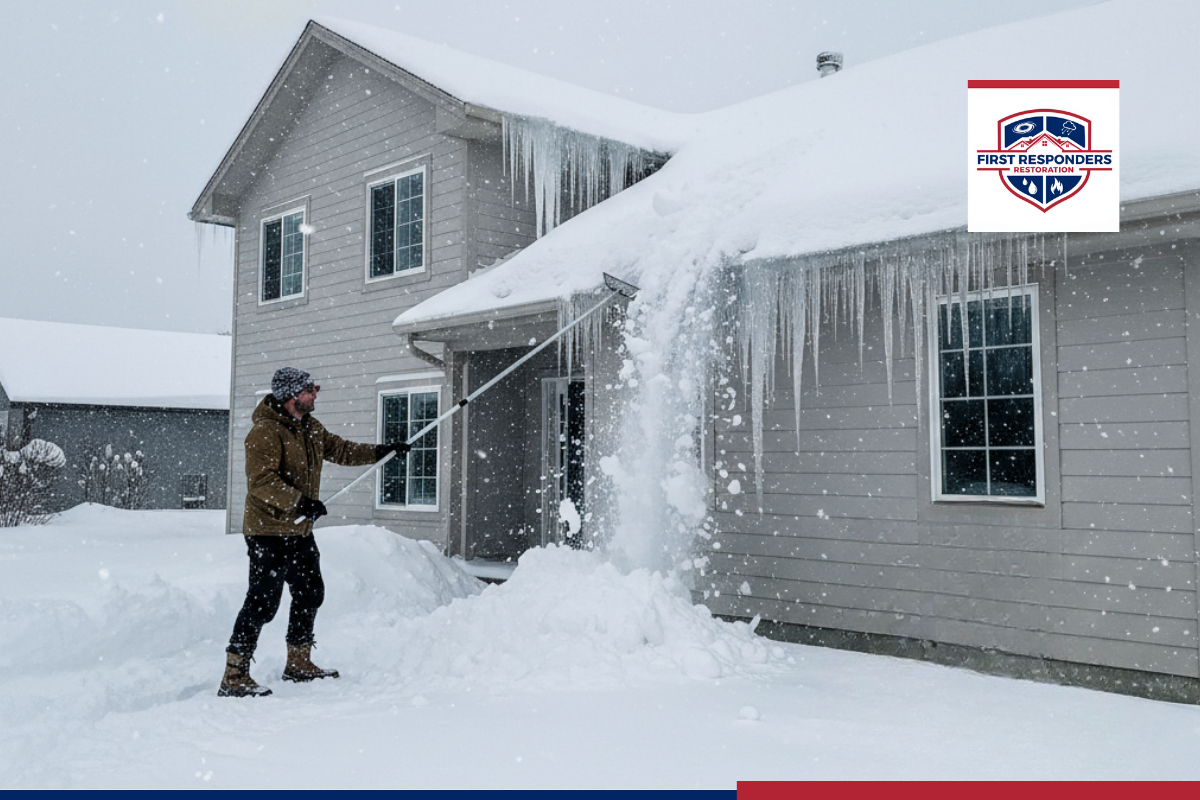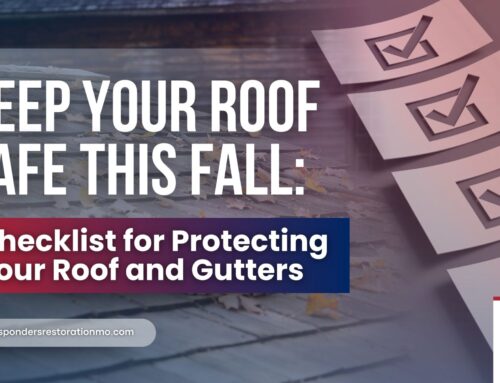Winter Home Safety: Preventing Roof Damage from Ice and Snow
Winter brings cozy nights, snowy mornings, and plenty of holiday cheer, but it also brings serious risks for your home, especially your roof. Just as fall gutter cleaning protects your home from fire hazards, preparing your roof for winter is essential to prevent costly damage from ice, snow, and freezing temperatures.
Your roof is your home’s first line of defense against the elements. When it fails under the stress of ice dams, snow loads, or freezing rain, the consequences extend well beyond the shingles. Water can seep indoors. Insulation can lose its effectiveness and structural beams can bend under the strain. Mold may begin to grow, and before you realize it, what seemed like a minor issue has become a problem affecting every corner of your home. By taking proactive steps before and during the cold season, you can keep your home safe, warm, and dry while avoiding thousands of dollars in potential repairs.
How Ice and Snow Damage Roofs
Winter weather may look beautiful when snow drapes across trees and rooftops, but for your home it can be destructive. Ice and snow create challenges in multiple ways, each with the potential to shorten the life of your roof.
Falling ice or broken branches can puncture roofs, damaging shingles and underlayment in ways that require immediate attention.
Preparing Your Roof for Winter

The good news is that homeowners have many ways to prepare before snow and ice arrive. The process begins with a careful inspection of your roof. Missing or curling shingles should be replaced, and special attention must be paid to flashing around chimneys, vents, and skylights. These areas are prime entry points for water if they are not properly sealed.
Ice Dam Prevention
Because ice dams are one of the most destructive winter problems, preventing them deserves special attention. Clean gutters are the first line of defense, but they are not the only one.
Some homeowners go a step further and install ice-and-water shield membranes beneath shingles at vulnerable roof edges. These hidden layers act as a backup defense, preventing seepage even if an ice dam forms. It’s an investment that often pays off in peace of mind.
Responding to Winter Storms

No matter how prepared you are, severe winter storms can still challenge your roof. The most important thing after a storm is to assess safety. Walk around your property and look for sagging areas, heavy snow buildup, or long icicles. Resist the urge to climb onto the roof yourself; icy conditions make this dangerous.
If snow accumulation is heavy, use a roof rake to clear the lower sections. Always pull snow downward; never push it upward against shingles. If the snow is too high to reach or if you notice significant ice dams, call a professional. They have the training and equipment to remove snow and ice without causing additional damage or risking injury.
Documentation is also important. If you notice leaks, cracks, or water stains indoors, take photos right away. This evidence will be helpful if you need to file an insurance claim. Staying alert to indoor warning signs, such as musty odors or sudden drafts in the attic, can also give you an early indication that water is entering where it shouldn’t.
Protecting the Inside of Your Home
Roof damage does not stay outside. It quickly makes its way indoors. Stained ceilings, peeling paint, drafts, and mold growth are all signs that winter weather has already breached your defenses. Keeping an eye on these indicators allows you to address problems before they worsen.
Using a dehumidifier during snowy months helps control moisture levels inside, making it harder for mold to thrive. Smart leak sensors, placed in attics or under ceilings, provide early warnings when water begins to seep through. Regular HVAC maintenance also ensures your heating system delivers steady warmth without creating hot and cold spots that accelerate roof melt.
Protecting your St. Louis home this winter in Missouri can be challenging. From heavy snowfalls to sudden ice storms, St. Louis homeowners face unique challenges every season. The good news? You don’t have to face them alone.
At First Responders Restoration, we specialize in roof waterproofing, roofing repair, and siding repair in St. Louis, MO. Our trained experts know how to spot early warning signs, apply protective waterproofing solutions, and repair winter storm damage before it becomes a costly disaster.
Long-Term and Community Solutions
Roof waterproofing isn’t just about short-term fixes. It’s about protecting your home, supporting your community, and investing in sustainable solutions that last for years.
Roof Prep Equals Peace of Mind
Just as gutter cleaning in the fall reduces fire risks, preparing your roof for winter keeps your home safe from ice and snow damage. By inspecting your roof, maintaining proper insulation, and responding wisely to storms, you create a safer environment for your family.
Winter should be a season of comfort, not concern. With preparation, you can sip hot cocoa by the fire without worrying about leaks, ice dams, or roof collapse overhead. If you’d like to explore more about how roof and gutter maintenance reduces risks, revisit our first blog: Fall Fire Safety: Why Gutter Cleaning Protects Your Home.
Together, these seasonal strategies ensure your home is protected year-round.








Leave A Comment